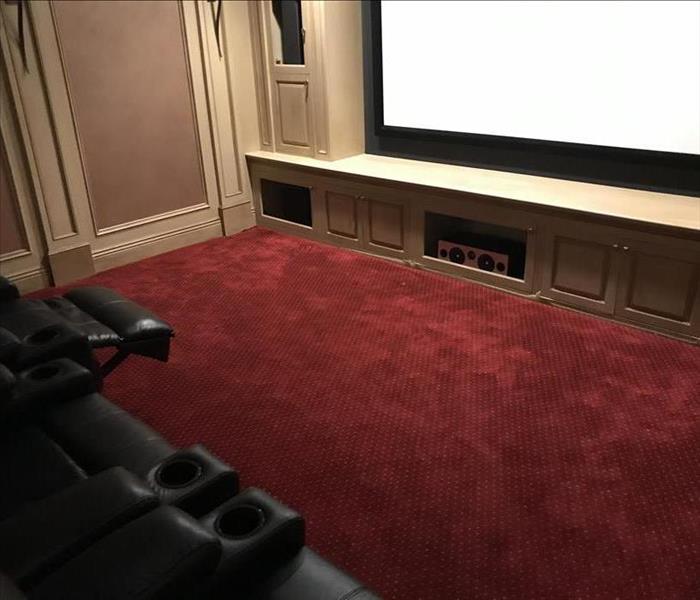Does a Home Need Mitigation or Restoration After Water Damage?
10/26/2020 (Permalink)
 SERVPRO rescues the Closter Home Theater from water damage with a rapid response using advanced equipment.
SERVPRO rescues the Closter Home Theater from water damage with a rapid response using advanced equipment.
SERVPRO Uses Both Mitigation and Restoration to Return Your Closter Home to Pre-Loss Condition
Many homeowners do not grasp the difference between mitigation and restoration. They may even assume that two different companies are required to provide the needed services. But a professional water restoration company in Closter, like SERVPRO, does both.
What is Mitigation?
When a water intrusion occurs that requires water extraction in Closter, emergency mitigation occurs as quickly as possible. The focus during this time is preventing further damage to your home and the impacted content. Mitigation processes could include:
- Water extraction
- Setting up dehumidifiers
- Establishing drying goals
- Removing content to unaffected areas
- Blocking up furniture
- Containment to prevent water migration
- Dealing with safety concerns
What is Restoration?
Returning water-damaged items and structural elements to preloss condition is the focus of restoration. Once everything has been cleaned and dried, the restoration process can begin. Controlled demolition can be a part of the restoration. Examples of the restoration process would be:
- Repainting walls or redoing wallpaper
- Refinishing wood surfaces
- Replacing drywall and ceiling panel sections
- Replacing installation
These are just a few processes involved in water damage restoration. Effective water restoration requires qualified technicians. Our Institute of Inspection, Cleaning and Restoration Certifications (IICRC) techs have hundreds of hours of training under their belt. IICRC training means they are professionals and experts at mitigating water damage and restoring homes. Their expertise includes:
- CCT – carpet cleaning
- OCT – odor control
- RCT – rug cleaning
- UFT – upholstery & fabric cleaning
What is Controlled Demolition?
Mitigation solutions often require implementing controlled demolition techniques. It can help regulate the spread of water migration and help with water extraction. With controlled demolition, materials too damaged to salvage get discarded, reducing the amount of cleaning and recovery needed. Only affected portions get removed, and the build-back of the home is easier. This means a more efficient and less costly restoration.
After a water incident, everything from flooring to furniture can be impacted by the moisture. Hygroscopic materials, such as drywall, readily absorb moisture both from standing water and water vapor. Certain materials are more susceptible to damage from water loss leading to controlled demolition. They include:
- Ceiling tiles
- Carpet and padding
- Wood framing
- Drywall
- Cabinets
- Hardwood flooring
While it is always our goal to restore rather than replace, there are certain items such as particle board cabinets, that are cheaper to replace. Examples of controlled demolition in conjunction with water extraction could involve drilling holes at a certain level evenly across a wall near the bottom. This allows for moisture to flow out and air to flow in enhancing the drying process. The technicians then use effective cleaning methods to remove the mess caused by the demolition. They use cleaning products to remove residues and adhesives from surfaces. Dry vacuuming with HEPA filters is also done.
What Tools Does SERVPRO Use for Water Cleanup?
After a substantial water intrusion, standing water can be a big problem. Items become oversaturated, and the risk of secondary damage like mold increases. SERVPRO professionals use professional water extraction equipment to get rid of excess moisture. We have at our disposal a variety of pumps, including powerful truck-mounted pumps, submersible pumps, and portable pumps. Dry mats, carpet wands, squeegees, and rovers are other tools in the restoration arsenal.
Industrial strength dehumidifiers and air movers get used in the right ratio to complete the drying process. The process from start to finish is monitored and assessed with moisture meters, moisture probes, and thermal imaging. Our technicians use EPA-registered cleaning agents. If mold or contaminated water is a concern, antimicrobials and antifungals are applied to affected surfaces. If there is a problem with odors, we have deodorizing tools and agents to take care of that as well.
Professional & Caring Service
As homeowners and residents in the Closter area, we understand how even a minor water accident can impact your home life. Nobody wants to have technicians in and out of their homes. But if a water situation does happen, you also want the best possible company that understands water extraction and home restoration. Our SERVPRO technicians have a solid reputation for providing mitigation and restoration services to local homes.
We know a water incident can occur at any time of day or night, which is why we are always available. Time is crucial when dealing with water extraction, and we strive to arrive as quickly as possible. We come prepared for both mitigation and restoration. There is no need for multiple companies to do one job.
Contact SERVPRO of Northeast Bergen County at (201) 244-0100 for expert water extraction service. We are licensed and bonded – Contractor Licenses: General: 13Vh001305854800. We’re Faster To Any Size Disaster.






 24/7 Emergency Service
24/7 Emergency Service